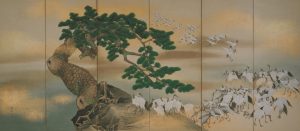Part I: October 6 (Saturday) to November 21 (Wednesday), 2018
Part II: November 23 (Wednesday) to January 14 (Monday/National Holiday), 2019
Venue: Kankai Pavilion, Hara Museum ARC

This two-part exhibition features works from the Hara Rokuro Collection centered on two themes: praises and prayers. The first part, Praises, is the celebration of life as represented in works by Mori Tetsuzan and Nagasawa Rosetsu, disciples of Maruyama Okyo, which appear together with a preparatory sketch made by Okyo for his masterpiece Landscape of Yodo River. Mori Tetsuzan’s A Hundred Cranes, a spectacular and powerfully composed work that features two popular symbols for long life in Japan: the crane and pine tree.
The second part, Prayers, is the pictorial evocation of hope as seen in works of the Chinese painter Shen Nanpin, a greatly influential figure in Japanese painting during the middle part of the Edo era. Symbols for longevity–the crane, pine tree, orchid and rose–are also featured in his uniquely composed paintings as auspicious symbols of longevity. Part 2 also includes Scene of mournful assembly at the death of Buddha, painted during the Momoyama period, a work that is literally composed around the act of prayer.
Featured Works
[Part I & II] Traditional Art: Landscape of Yodo River, Maruyama Okyo hand scroll Edo period / Pair of Satsuma ware sake bottles with portable maki-e case(buriburi) Edo period, 19th century
[Part I] Nagasawa Rosetsu, Jumping horse and a child, hanging scroll, ink on paper, Edo period, 18th century / Fisherman and his son, Qing dynasty / A hundred Cranes, Mori Tetsuzan, Edo period / Shoulao and flowers, attributed to Sakai Hoitsu Edo period
[Part II] Scene of mournful assembly at the death of Buddha, hanging scroll, Momoyama period / A pair of cranes, A pair of cranes and an old pine tree, Shen Namping Qing dynasty 18th century / Landscape of Mt. Fuji, Shiba Ko’kan hanging scroll Edo period 18th century / Fish and weeds, Lin Dengke, Qing dynasty / Landscape, Tani Buncho, Edo period / Seaside Landscape with sunrise, Yokoyama Taikan, Meiji period
Contemporary Art: Anish Kapoor / Hiroshi Sugimoto / Tomoko Yoneda and others
Hara Museum ARC
Address: 2855-1 Kanai, Shibukawa-shi, Gunma 377-0027 Tel 0279-24-6585 Fax 0279-24-0449
E-mail arc@haramuseum.or.jp http://www.haramuseum.or.jp (official website) http://mobile.haramuseum.or.jp (mobile site)
http://www.art-it.asia/u/HaraMuseum (blog) http://twitter.com/HaraMuseumARC (Twitter)
Hours: 9:30 am – 4:30 pm (last entry at 4:00 pm)
Closed: Thursdays (except January 3), December 4-7, 11-14 and January 1 *Subject to temporary closure in the event of severe weather.
Admission: General 1,100 yen, Students 700 yen (high school and university) or 500 yen (elementary and junior high), Free for Hara Museum members, 10% discount for a group of 20 or more, Combination ticket for Hara Museum ARC and Ikaho Green Bokujo (except during Golden Week): General 1,800 yen; Students 1,500 yen (high school and university) or 1,400 yen (junior high), 800 yen (elementary), half price for those over 70, discount for groups of 20 or more
*Visitors to the Kankai Pavilion can view the on-going exhibition in the contemporary art galleries as well.
*Children must be accompanied by an adult.
*For residents of Gunma Prefecture: Free admission for elementary and junior high school children every Saturday during the school term/200-yen-discount on admission for up to five persons upon presentation of the Guchoki Passport.
*Visitors to the Kankai Pavilion can view the on-going exhibition in the contemporary art galleries as well.
Directions: By train: Take the Joetsu Shinkansen to Takasaki, change to the Joestu Line, and disembark at Shibukawa. From Shibukawa, ARC is 10 minutes away by taxi or 15 minutes by bus (take the Ikaho Onsen bus to ″Green Bokujo Mae″). By car: 8 kilometers (about 15 minutes) from the Kan-etsu Expressway Shibukawa Ikaho Interchange (in the direction of Ikaho Onsen).
